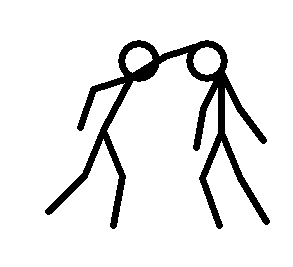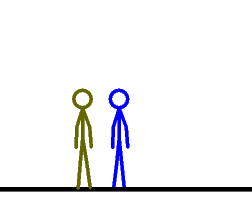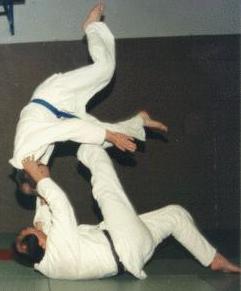
Grappling, in hand-to-hand combat, describes sports that consist of gripping or seizing the opponent. Grappling is used at close range to gain a physical advantage over an opponent, either by imposing a position or causing injury. Grappling is a broad term that encompasses many disciplines. These various martial arts can be practiced both as combat sports and for self-defense. Grappling contests often involve takedowns and ground control, and may end when a contestant concedes defeat, also known as a submission or tap out.
Professional wrestling throws are the application of professional wrestling techniques that involve lifting the opponent up and throwing or slamming them down. They are sometimes also called "power" maneuvers, as they are meant to emphasize a wrestler's strength. Many of these moves are used as finishers by various wrestlers, who refer to them by several different names that reflect their gimmick. Moves are listed under general categories whenever possible.
Professional wrestling holds include a number of set moves and pins used by performers to immobilize their opponents or lead to a submission. This article covers the various pins, stretches and transition holds used in the ring. Some wrestlers use these holds as their finishing maneuvers, often nicknaming them to reflect their character or persona. Moves are listed under general categories whenever possible.

Collegiate wrestling is the form of wrestling practiced at the college and university level in the United States. This style of wrestling, with some slight modifications, is also practiced at high school and middle school levels, and also among younger participants. The rules and style of collegiate or folkstyle wrestling, differs from other styles of wrestling that are practiced around the world such as those in the Olympic Games: freestyle wrestling and Greco-Roman wrestling.
A suplex is an offensive move used in sport wrestling as well as amateur wrestling and professional wrestling. It is a throw that involves lifting the opponents and bridging or rolling to slam them on their backs.
Aerial techniques, also known as "high-flying moves" are maneuvers in professional wrestling using the ring's posts and ropes as aids, in many cases to demonstrate the speed and agility of smaller, nimble and acrobatically inclined wrestlers preferring this style instead of throwing or locking the opponent. Due to injuries caused by these high risk moves, some promotions have banned the use of some of them. The next list of maneuvers was made under general categories whenever possible.
Strikes are offensive moves in professional wrestling, that can sometimes be used to set up an opponent for a hold or for a throw. There are a wide variety of strikes in pro wrestling, and many are known by several different names. Professional wrestlers frequently give their finishers new names. Occasionally, these names become popular and are used regardless of the wrestler performing the technique.

In martial arts and combat sports, a takedown is a technique that involves off-balancing an opponent and bringing them to the ground with the attacker landing on top. The process of quickly advancing on an opponent and attempting a takedown is known as shooting for a takedown, or simply shooting. Takedowns are usually distinguished from throws by amplitude and impact, where the purpose of a throw is to outright eliminate the opponent while purpose of a takedown is to bring the opponent down on the ground, assume a dominant position and then proceed to finish them with jointlocks, chokeholds or ground and pound. In rulesets of many sports such as Judo and Sambo, a well executed throw will end the match while the match will continue on the ground if a takedown is used instead. Takedowns are featured in all forms of wrestling and Judo.

In wrestling, a pin is achieved by holding an opponent's shoulders to the mat for a three count. Pinfall is the term used in professional wrestling which is a way to win the match for that person or team.

A piledriver is a professional wrestling driver move in which the wrestler grabs their opponent, turns them upside-down, and drops into a sitting or kneeling position, driving the opponent head-first into the mat. The technique is said to have been innovated by Wild Bill Longson.

A powerbomb is a professional wrestling throw in which an opponent is lifted and then slammed back-first down to the mat. The standard powerbomb sees an opponent first placed in a standing headscissors position. The opponent is then lifted on the wrestler's shoulders and slammed down back-first to the mat. A prawn hold is commonly used for a pinning powerbomb.

In professional wrestling a DDT is any move in which the wrestler has the opponent in a front facelock/inverted headlock and falls down or backwards to drive the opponent's head into the mat. The classic DDT is performed by putting the opponent in a front facelock and falling backwards so that the opponent is forced to dive forward onto their head. Although widely credited as an invention of Jake Roberts, who gave the DDT its famous name, the earliest known practitioner of the move was Mexican wrestler Black Gordman, who frequently performed it during the 1970s.
An armlock in grappling is a single or double joint lock that hyperextends, hyperflexes or hyperrotates the elbow joint or shoulder joint. An armlock that hyper-extends the arm is known as an armbar, and it includes the traditional armbar, pressing their elbow into your thigh, and the triangle armbar, like a triangle choke, but you press their elbow into your thigh. An armlock that hyper-rotates the arm is known as an armcoil, and includes the americana, kimura, and omaplata. Depending on the joint flexibility of a person, armcoils can either hyper-rotate only the shoulder joint, only the elbow joint, or both the elbow joint and shoulder joint. Generally, armcoils hurt more than armbars, as they attack several joints at the bone and muscle.

A nelson hold is a grappling hold which is executed by one person from behind the opponent, generally when both are on the mat face down with the opponent under the aggressor. One or both arms are used to encircle the opponent's arm under the armpit, and secured at the opponent's neck. Several different nelson holds exist, and they can be separated according to the positioning of the encircling arm(s). A nelson is used to control an opponent or to turn them over onto their back and execute a pin.

A grappling hold, commonly referred to simply as a hold that in Japanese is referred to as katame-waza, is any specific grappling, wrestling, judo, or other martial art grip that is applied to an opponent. Grappling holds are used principally to control the opponent and to advance in points or positioning. The holds may be categorized by their function, such as clinching, pinning, or submission, while others can be classified by their anatomical effect: chokehold, headlock, joint-lock, or compression lock. Multiple categories may be appropriate for some of these holds.

In martial arts, a throw is a grappling technique that involves off-balancing or lifting an opponent, and throwing them to the ground, in Japanese martial arts referred to as nage-waza, 投げ技, "throwing technique". Throws are a subset of takedown (grappling). Certain throwing techniques called sacrifice throws involve putting oneself in a potentially disadvantageous position, such as on the ground, in order to execute a throw.

In wrestling, an overhook, also incorrectly called a wizard, is a clinch hold that is used to control the opponent. An overhook is performed from any direction by putting an arm over the opponent's arm, and encircling the opponent's arm or upper body. Having an overhook with one arm is called a single overhook, while having overhooks with both arms is known as double overhooks. Overhooks are typically employed in response to underhooks by an opponent.

The cradle is a basic technique in amateur wrestling. Its name refers to the move's similarity to the way a person holds an infant in their arms. The wrestler performs the cradle by grabbing the neck of their opponent with one arm and wrapping the elbow of the other arm behind the knee of the opponent. The wrestler then locks both hands together to prevent their opponent from escaping.

A pin, or fall, is a victory condition in various forms of wrestling that is met by holding an opponent's shoulders or scapulae on the wrestling mat for a prescribed period of time. This article deals with the pin as it is defined in amateur wrestling.












